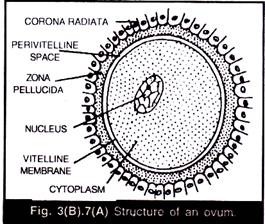ADVERTISEMENTS:
Ovum refers to secondary oocyte stage of oogenesis, where the second maturation division is yet to occur.
In this condition the matured ovum is released from ovary and enters into uterus in mammals for fertilization. In mammals including man the ovum is discharged from the Graafian follicle (ovulation) with one polar body.
Each ovum is a rounded and non-motile structure. In mammals, the size of the egg is extremely small (0.15 mm in man).
ADVERTISEMENTS:
The cytoplasm of the egg is called ooplasm. It contains a very little amount of yolk in man and therefore it is alecithal. In animals where huge amount of yolk is present, the cytoplasm of egg consists of lipoproteins, pigment granules, water, and UNA along with other cytoplasmic organelles.
The peripheral layer of ooplasm is known as cortex and it contains many microvilli and cortical granules.
Microvilli are tubular outrushing of plasmalemma for transportation of substances into and out of egg cytoplasm. The cortical granules though not present in mammalian eggs are mucopolysaccharides covered over by Golgi membranes. The nucleus is large and centrally placed in mammals but towards the animal pole in yolky eggs.
It absorbs cytoplasmic liquid and swells into a germinal vesicle. In man the ovum is covered over by a thin vitelline membrane which is further covered over by another primary membrane known as zona pellucida. There is a narrow space between these two membranes known as perivitelline space. During discharge of ovum from the graafian follicle, several layer’ of epithelial cells adhere to the outer surface of zona pellucida and are arranged radially forming corona radiata (Fig. 3(B).7A & B).

